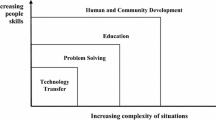Abstract
A major worldwide trend toward the use of agroforestry and other sustainable agricultural systems has heightened the need for training. Such training is currently underway on every continent. This paper addresses the general principles and practices of training in agroforestry focusing on who needs training, what training is required, and designing training programs. The breadth and depth of training required by the various clientele groups — villagers, politicians, technicians, and professionals — are quite different. Politicians require broad but rather shallow training in agroforestry making them aware of the physical and biological constraints, as well as the social and economic aspects of agroforestry. Villagers require applied, hands-on training but teaching principles also enables them to develop and modify their own systems. Technicians and professionals both need more in-depth and thorough training consisting of both principles and practices. Spaid's approach to training involves the 4-D program: Define, Design, Develop and Deliver. Another model for training, the critical events model, emphasizes the need for feedback and evaluation in every stage of the training program. If a series of well-defined steps is followed, valuable, efficient, effective training programs that further the understanding and practice of agroforestry can be a reality.
Similar content being viewed by others
References
Bawden RJ, Macadam RD, Packham YJ and Valentine I (1984) Systems thinking and practices in the education of agriculturists. Agric Systems 13: 205–225
Huxley PA (1987) A combined systems, case study approach for agroforestry training. In Zulberti E (ed), Professional Education in Agroforestry, pp 122–127. International Council for Research in Agroforestry, Nairobi
Kearsley G (1982) Costs, Benefits and Productivity in Training Systems. Addison-Wesley Publishing Co. Reading, Massachusetts
Moris J (1981) Managing Induced Rural Development. International Development Institute. Bloomington, Indiana
Nadler L (1982) Designing Training Programs. Addison-Wesley Publishing Co. Reading, Massachusetts
Spaid OA (1986) The Consummate Trainer. Prentice Hall. Englewood Cliffs, New Jersey
Author information
Authors and Affiliations
Rights and permissions
About this article
Cite this article
Fisher, R.F. Agroforestry training: global trends and needs. Agroforest Syst 12, 49–56 (1990). https://doi.org/10.1007/BF00055573
Issue Date:
DOI: https://doi.org/10.1007/BF00055573




